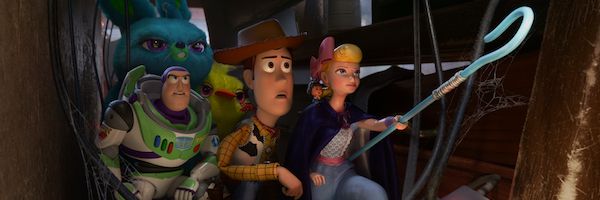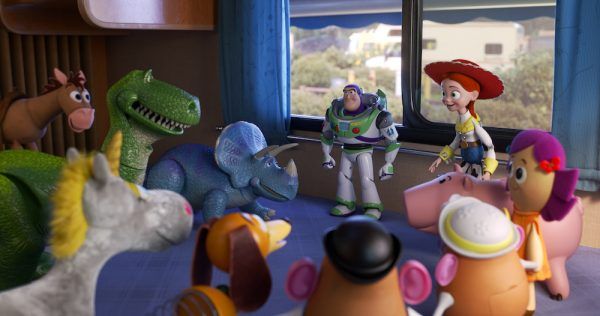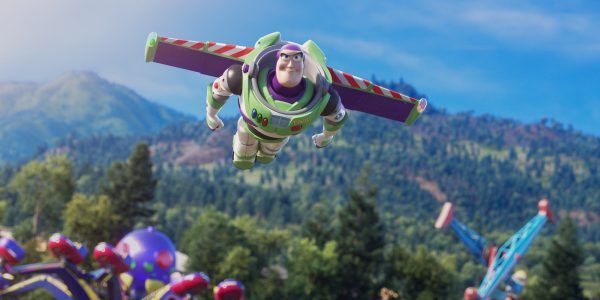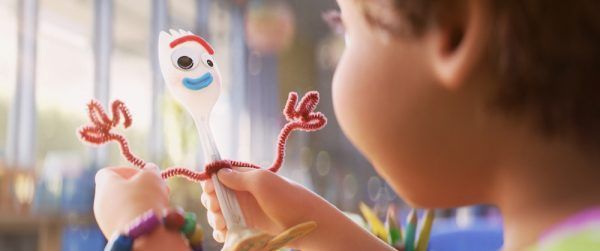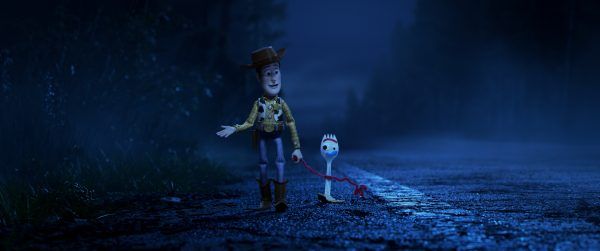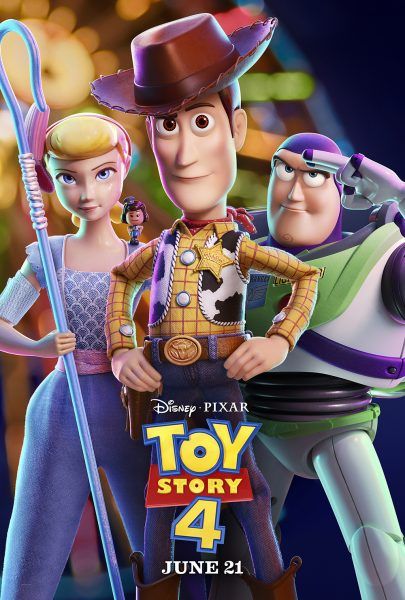Toy Story 4 is an adventure film, plain and simple, kind of like Raiders of the Lost Ark if the artifacts came to life and became the main characters. Set after Toy Story 3's quite frankly devastating ending, the film follows Woody (Tom Hanks) and Buzz Lightyear (Tim Allen) as they search for Bonnie's new favorite toy—a googly-eyed spork with legs named Forky (Tony Hale)—who gets lost on a road trip. But the rescue mission takes a turn for the nostalgic when Woody bumps back into Bo Peep (Annie Potts), who has been living as a "lost toy" without a home or owner since the original Toy Story.
On location at Pixar's San Francisco campus, Collider sat down with director Josh Cooley and producers Jonas Rivera and Mark Nielsen to discuss the film, Bo's arc, how Buzz Lightyear fits into the story, keeping images just shy of totally photorealistic with the powerful animation technology they have these days, and whether Toy Story 4 wraps up these characters' arcs.
The sense we got today is that this movie changed a lot since the beginning. I'm wondering what it was like in its earliest, nugget-of-an-idea form and what was the catalyst to change it into what it is now?
JOSH COOLEY: The earliest version of it, Bo Peep was always a part of that. It felt right because we were like, "This is something we can tie into what we've seen in the past but also can help kick off this story." That was always a part of it. The locations were always changing but Bo Peep was always there. I think it would be probably when we realized...actually, personally, I was thinking about my wife and how she's lived a different life from me. When we got together I feel like my eyes were opened to seeing how other people live and how everything works. Just stuff I wasn't familiar with. I wanted to bring that into Bo a little bit. For me, personally, that was the moment I realized, "Oh, I can see how I can emotionally attach to this story. And also how it can affect Woody."
JONAS RIVERA: I remember that day. Just to echo that. The first question of, what was the first nugget of an idea? I think it was always about Bo Peep, and just honestly we found over the first few iterations it just wasn't deep enough. It was like, "Oh, cool, that's a cool question to ask." Where did Bo go? But that was like a plot thing. We mined that.
MARK NIELSEN: We used the words "romantic comedy..."
RIVERA: Yeah, and that was fun, and entertaining, but when [Cooley] came in with that idea that someone you know, close to you, completely changed the way you see the world...I remember, we all thought, "Okay, now that's interesting." That's not a plot thing. That's a character, world-view thing. When we started applying that to it, is when I, as producer, felt like, "Oh, there's something here. If you can do that in the Toy Story world, that's really cool." At least that's what I remember feeling. That's when it started to feel like a movie worthy of...
COOLEY: That was probably the first time I cried pitching. [laughs]
NIELSEN: It was early. That was when you first came on as director or pretty close to then, that we had that realization.
When people think of Toy Story, I feel like the first image they have is Woody and Buzz. But in the footage we saw, there wasn't a ton of interaction between them. How do you make sure those two characters not only are an essential part of the plot, but that they didn't get lost in the shuffle?
COOLEY: I totally agree with you. That's the poster. One of the biggest things is, there are so many characters, and now that we're taking Andy's characters combined with Bonnie's, now there's an even bigger cast. Part of the fun of every Toy Story for me, going into it, was like, "Oh, there's more characters. There's stuff we didn't realize about this world." So it was already massive. But the important thing was that this is Woody's story. I wanted Bo to be an equal with Woody but not lose Buzz at all. It became essential for Buzz's relationship with Woody to be present in this film. He couldn't just become a side-character or anything like that. We all love Buzz but seeing the way they've evolved as friends over these films definitely helped influence this film as well.
What really stuck out in the footage we saw was the attention to detail on the characters, the scratches and the peeling stickers, the wear and tear. I'm curious if you had a line visually between "that looks incredible and so realistic" and "that doesn't look like animation anymore"?
RIVERA: It's a great question and a tricky thing. We tried to adhere to three things that were the three visual ingredients of the original Toy Story, which was a world where you build models with a little caricature, there's a little roundness and softness to tables and so forth. But the textures on those things are real. In fact, you even amplify it. If it's denim, you build it with a little more ridges to it. The lighting is theatrical, it's not just the practical lights of the sun, there's a little sense of theater to it. If you have those three things, those are the levers you have to get the imagery. The rendering has progressed so you can get a little more fidelity in it. A lot of people say, "The rain looks totally real!" But yeah, when we were making that the effects team had footage and photos of real rain and it actually doesn't look anything like it. It's amplified and the raindrops that you see in the movie are like six times bigger. So our hope is that it feels real and that somewhere between those two the audience would know if it started to get too photorealistic it would break. I think we get pretty close to it but we still stand by that those are the same three ingredients.
COOLEY: You know what I think is actually emphasizing this point in this film? The camera. We're able to make the depth of field...we're like, "Oh, if we bring more depth of field they'll feel smaller." It feels like a real camera. We add handheld movement to it. It's almost like the cameraman is a real person. It's making everything else feel heightened.
RIVERA: There's a shot in Wall-E where the shopping cart goes down the thing and it goes out of the focus pull then catches back up to it. That was where it was like, "Oh, someone missed the focus pull." And of course, it was by design. It's all there to make it feel like there's a grammar.
I'm very curious why Forky is not named Sporky.
COOLEY: Well, you know, we were coming up with a bunch of different names for him, and I showed a picture of him to my son. I think he was probably four at the time, and I go, "Hey buddy, what do you think the name of this character is?" He looks at it and he goes, "Hmm, Fork Face." And I'm like, "That's hilarious. We cannot use it." But the fact that he's around the same age as Bonnie and didn't know what a spork was, I thought, "That feels real to me." So Forky felt like a kid would name him that.
RIVERA: I kind of like that the name is a little wrong. [laughs]
COOLEY: Yeah, like even that is wrong.
NIELSEN: Bonnie might not even know he is a spork. She's going into kindergarten. It's a fork to her.
COOLEY: In fact, we did record a line for the very end of the movie. The very, very end of the movie we had Ham going, "Wait a second, he's a spork. Why's he named Sporky?"
Speaking of the end of the movie, should this be the final Toy Story movie, either forever or in this incarnation, I'm wondering if you felt that it wrapped up each characters' story dating back to the first movie?
COOLEY: A couple things. One of the challenges of this film was we didn't want to not include the other films at all. Woody has obviously transitioned from Andy to Bonnie, so that's a big part of this movie. It's part of the reason we're making it. So it had to connect to the other films. We wanted it to also be self-contained as well. Every one of these movies, there is an ending to it but it does feel like it could continue. We don't know if we're going to make another one. We didn't know we were going to make two or three or four. But I'm very happy with this one, and I feel like, in the same tradition, it has a happy ending and it could be the end, it could not be.
NIELSEN: It's going to stand alone as a film, for sure.
Toy Story 4 hits theaters on June 21. For a full report on the plot details and behind-the-scenes facts we learned at Pixar, click the link right here.

